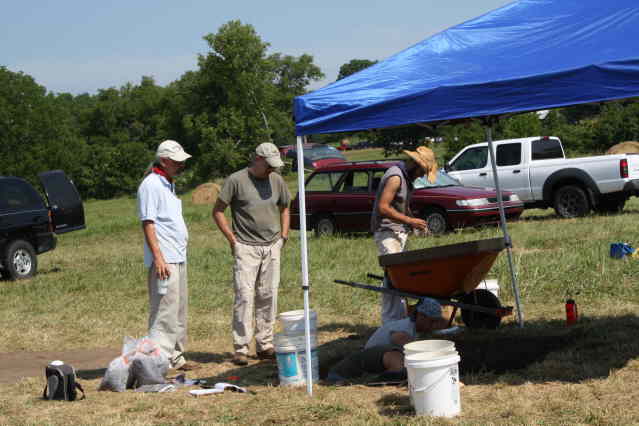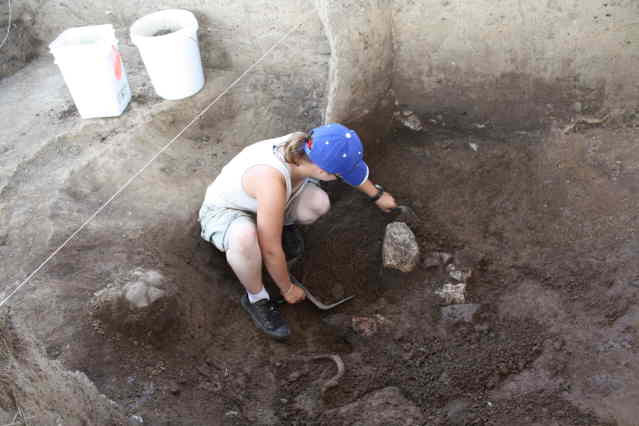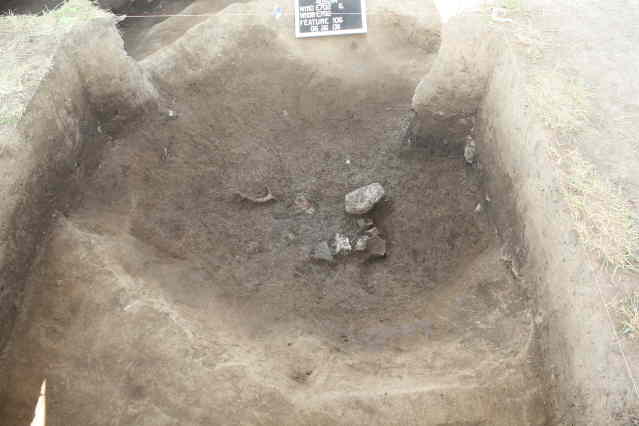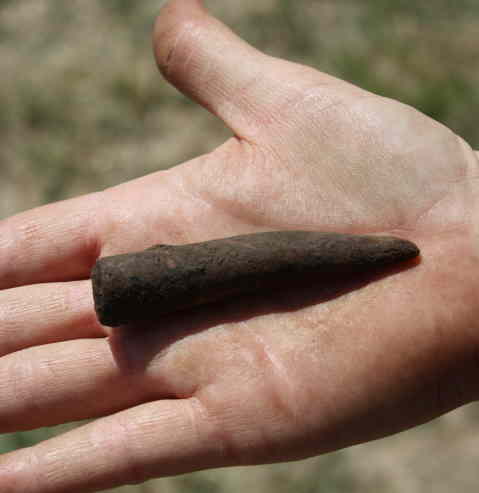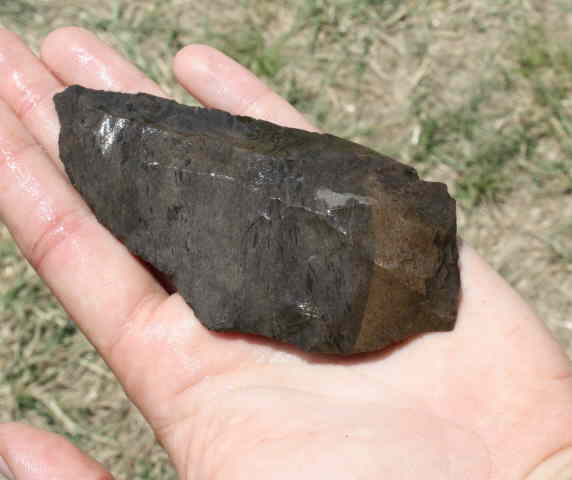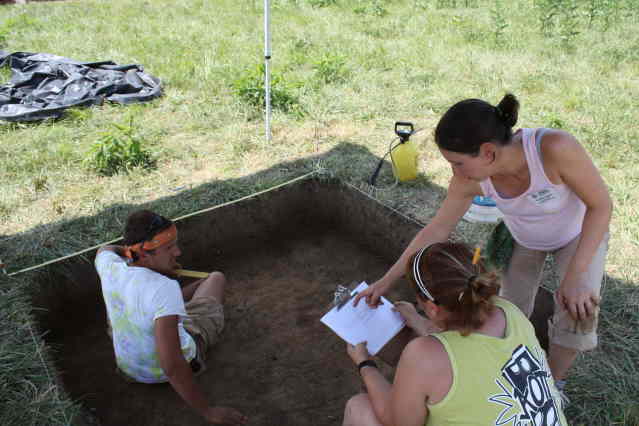
Field Projects: 2005-2011

| CASTALIAN SPRINGS ARCHAEOLOGICAL PROJECT Field Projects: 2005-2011
|
On June 2, we will be conducting an orientation lecture from 8:00 am until 4:30 pm on the MTSU campus.
We will begin on-site preparations on June 3.
Our field class started up this morning as it always does -- with a lot of slow and
tedious work preparing tools and equipment for use. A beautiful morning to start work -- slightly overcast with a nice breeze. The afternoon was a bit less comfortable -- with temperatures up into the upper 80s/low 90s and the humidity almost in the same figures. By 8:00 am, we were moving, unloading, and organizing the half dozen
truckloads of equipment and supplies that will carry us through the next
few weeks. By mid morning, we had started laying out the grid for our first seven excavation
units of our 2008 summer field season.
By late morning, we had started stripping the sod from the units. By closing time, the first "level" of each unit (about 10 cm or 4 inches in thickness) was about complete. Our first efforts this summer are to investigate the "village area" on the western edge of this ancient town -- and investigating a low linear earthwork that might be a remnant of the palisade on the western part of the site. We'll continue to work here over the next several days
-- hoping to cross the trench of the palisade wall.
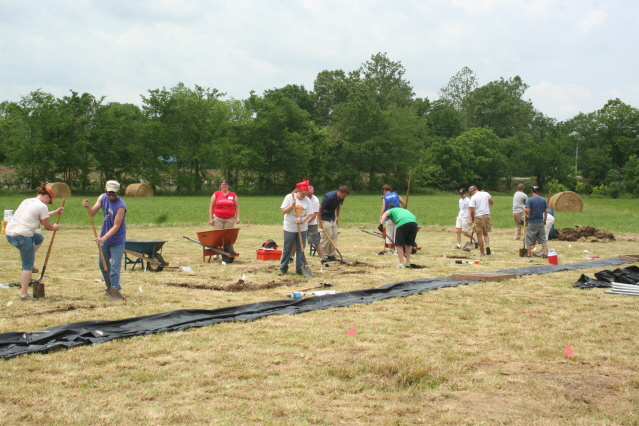
Today was a beautiful June day to be outside -- the humidity down, not too hot, and a nice breeze out of the south and west. After unloading our equipment and uncovering the excavations, we starting shovel skimming our way down through the upper zones of disturbed soil in the plowzone. Here Matt and Grey are skimming while others work in the background. Even though we are currently removing plowzone -- the upper 20 cm or so of soil disturbed by decades of plowing -- we are practicing our artifact recovery techniques. All soil removed from the units is sifted through 1/4 inch hardware mesh. Below, Valerie and Kristen look for artifacts in the screen. In these upper plowed soils, only the most resilient artifacts survive -- primarily stone tools. We discovered a significant number of small triangular arrowpoints in the excavations today -- these are the typical projectile points of the period we are interested in (from around A.D. 1100-1325). As we closed out a great day in the field, we covered our excavation units to protect them from the elements. By tomorrow, all seven of our excavation units should be through the plow zone and into undisturbed deposits from the Mississippian era.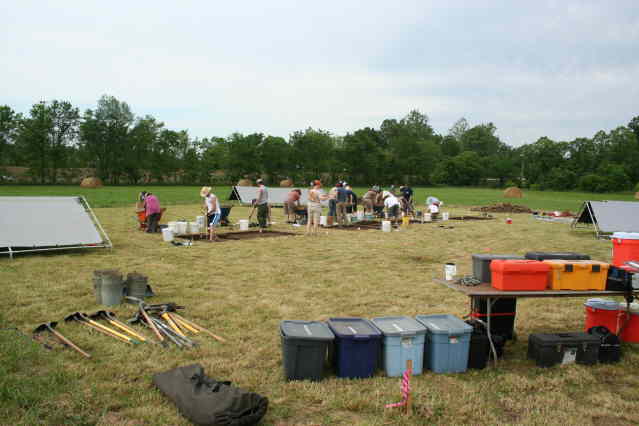

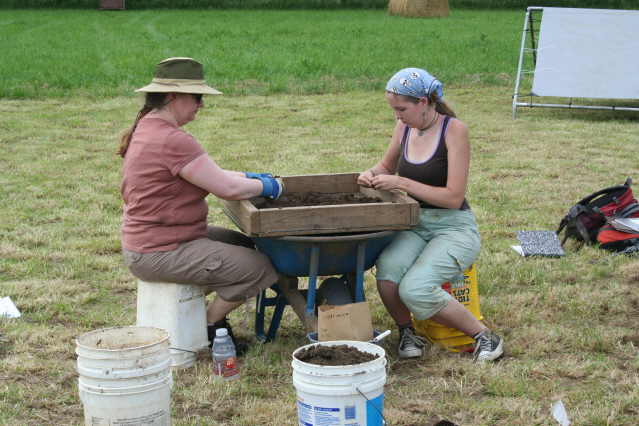

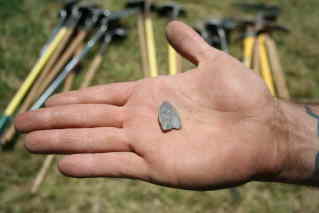
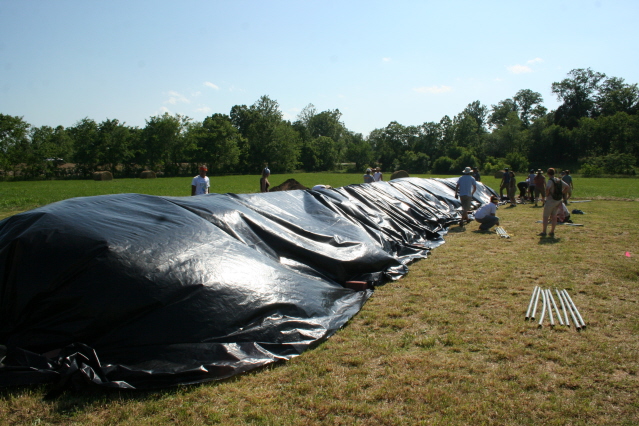
Another beautiful June today. In most of our seven excavation units, we worked through the plowzone today and began to find fragments of ancient pottery along with a few animal bones (mostly from white-tailed deer). In the photo below, the objects to the left and above the arrow are relatively large fragments of shell-tempered pottery vessels discarded some 800 years ago by native inhabitants. While not very photogenic at this point, they are representative of the types of objects most commonly found by archaeologists -- broken and discarded objects that we use to reconstruct the lifeways of the prehistoric inhabitants of the state. Thus far, most of the pottery is poorly preserved and very fragile -- but we have hopes that as excavations proceed on Friday, we will find better preserved specimens. Included in this "midden" -- an accumulation of trash over several decades -- are increasingly larger fragments of charred wood and other plants. These objects provide valuable opportunities to examine the environment around Castalian Springs almost a millenium ago -- and a chance to acquire radiocarbon dates for the associated artifacts. In one of the excavations units, a complicated set of different colored soils was uncovered towards the end of the day -- including light colored dense clays, gravel deposits, and silty alluvial soils. At this point, we aren't quite certain what to make of this -- we will explore it further on Friday. More news on Friday!

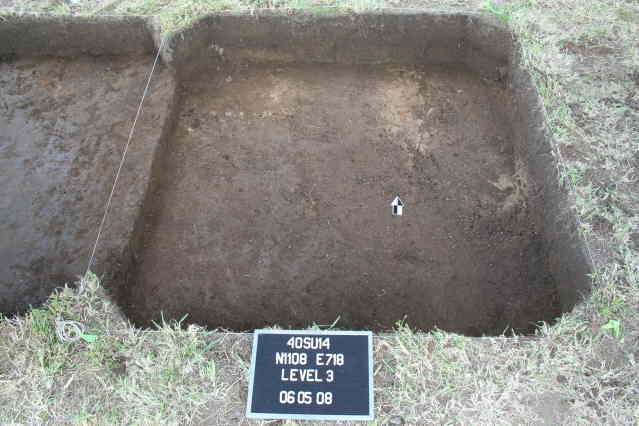
And yet one more beautiful day for June in Tennessee... Hot and humid -- but the nice constant and unusual breeze made things a lot more tolerable than usual! As our excavations proceeded today, the artifacts were better preserved -- we are now below the area disturbed by the plow over the past 200 years. The photo below shows a handful of pottery sherds... We are also finding some tantalizing hints of folks that occupied the landscape earlier than our Mississippian peoples -- the pottery fragment illustrated below is tempered with limestone and marked on the surface with cords. This is a hallmark of peoples who occupied the Tennessee landscape a century or two earlier (around A.D. 800-1000). As a field training course for budding archaeologists, we continued to instruct our students on various aspects of "doing" professional archaeology. Below, Eric (one of our experienced crew chiefs) explains to students how to draw profiles of excavation units. Students are also learning to take notes constantly as a record of our work. Below Jolene takes a break to update her notes. And, as many of our current excavation units have provided artifacts -- but not complex features like houses -- we also began laying out a series of new excavation units for next week. Saturday will be the first of our four volunteer days at Castalian Springs. We look forward to a great day of working with interested members of the public on our project on these days.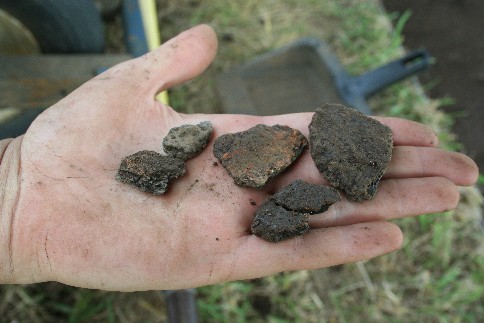
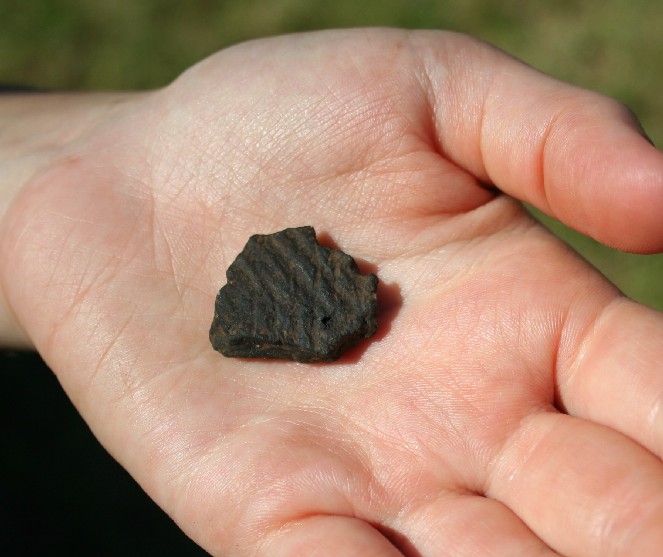
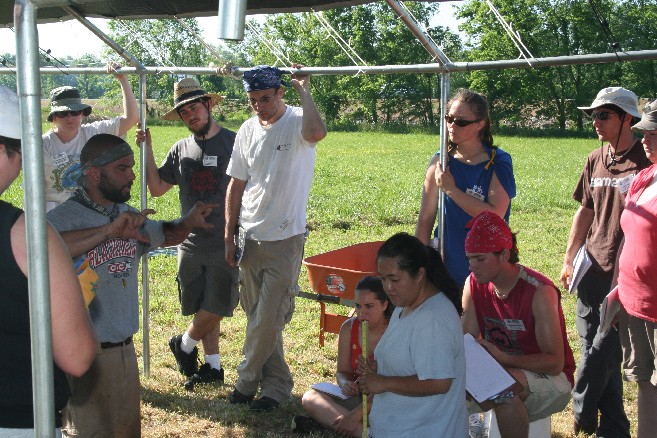

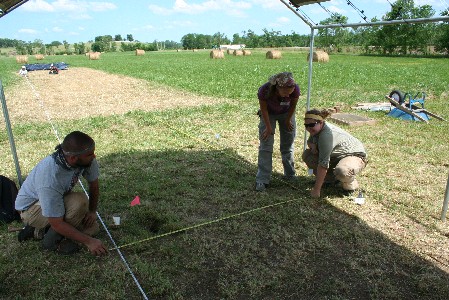
Today was the first of our four "Volunteer Days" when MTSU faculty and students welcome interested members of the public to participate in our project. While it was a bit on the warmish side -- we still had a very nice breeze to keep things in perspective. Along with about half of our student crew, we had a number of volunteers contributing to the project today -- we appreciate the interest and help of James Carll, Jennifer Clinton, Evan Cole, Edie Crane, Brandy Dacus, Lacey Fleming, LeAnne Johnson, Caroline Kiev, Chris and Drew Hogan, Ryan McNutt, Robert Miller, Steaven Robbins, and Jesse Tune. Today, we continued to find significant bits and pieces of the garbage left behind by the Native Americans who lived here centuries before us -- fragments of pottery, broken pieces of stone tools, and pieces of animal bone left behind from their meals. We continue to find every now and then a projectile point like that shown below. With the help of our volunteers, we also managed to start a couple of new excavation units that will be finished up next week. Below Jesse Tune works on one of these new units. As of now, your project directors are closing off for a much needed one day of break from the field. We expect to have more exciting news and discoveries this coming week as we get deeper and further into our project.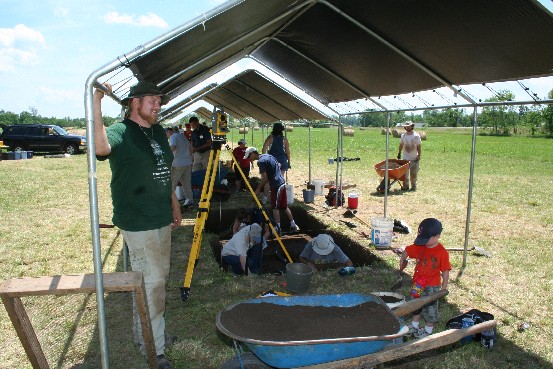
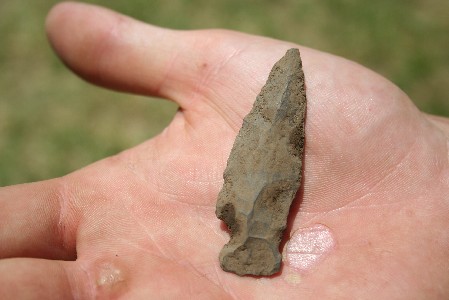

Today was a more typical June day for Middle Tennessee -- hot and humid, but we still had a little breeze starting around 8;30 that lasted most of the day. We even had a few friendly clouds pass over in the afternoon that gave a brief respite. We continued work in five of our first seven excavation units -- the artifacts continue to show up even as we proceed to 60+ centimeters (about 2 feet). In several of the units, we seem to be coming down on what may be the remnants of a Mississippian house set in an excavated basin. Another day or two and we should have some better answers to that question. We continue to find ample evidence of people who lived around Castalian Springs even before the folks who built the mounds at the site. The projectile point below dates to more than two thousand year ago. Screening recovers many more artifacts than would be found just in digging. Below, Salina and Tyler pick through the dirt to find the smallest artifacts. Some of the more intriguing pieces of pottery coming out today was a fragment of a jar handle -- this would have been a handle to a very large pot, holding a couple of gallons. We also found the intriguing and somewhat mysterious pottery object shown below. It is a solid node or pode of large size -- somewhat unusual for the Middle Tennessee area. We suspect at this point that it is the top of a very large "hooded bottle" -- more fragments will probably be retrieved on Tuesday. A number of the students assisted project directors Smith and Beahm in a very tedious and sweaty project today -- creating the first detailed topographic map of the mound site. Although standing out in the middle of a field in the hot sun carrying a surveying rod is certainly close to the bottom of the list of exciting things to do -- it is critical to producing a new map of the site that will help us to understand the layout of the earthworks. Tomorrow promises to bring some additional insights into the peoples who lived here about a thousand years ago.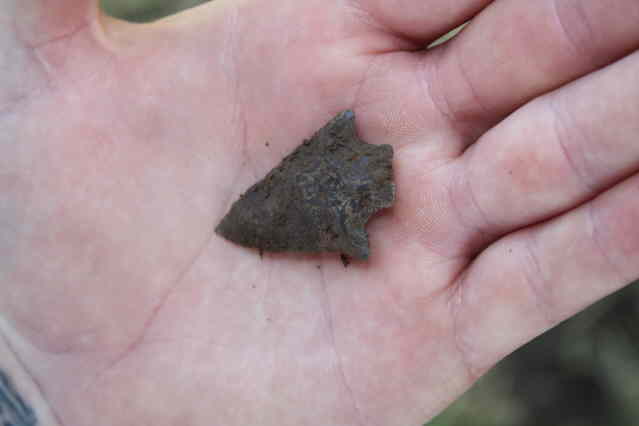

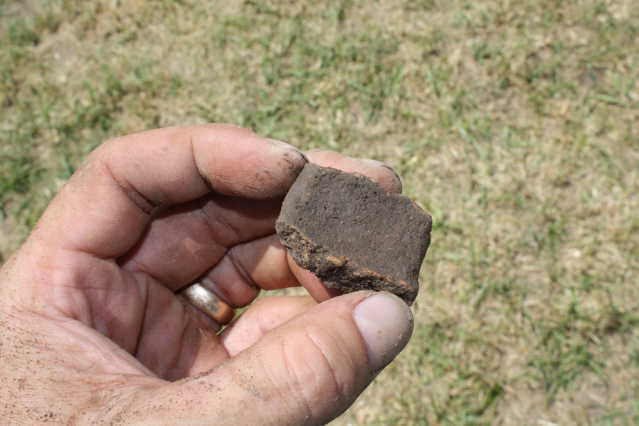
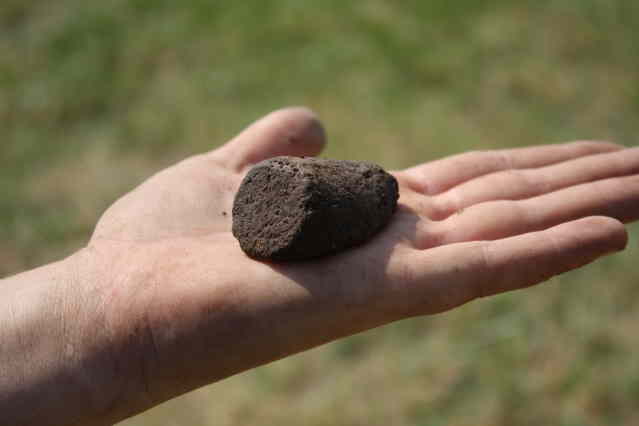
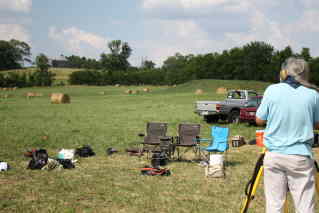
A nice day for archaeology in Middle Tennessee -- a cooler and overcast morning. Although the day started with about 75% humidity -- it had dropped to about 50% by midday and continued with some nice clouds and a breeze through the rest of the afternoon. The threat of showers and/or an isolated thundershower continues for the rest of the week -- but really a small chance. As a training course for budding archaeologists, we reached a point today where numerous "crews" stopped to take notes and record information as their excavations continued beneath the plow disturbed soils. Below, Grey takes notes on several interesting clusters of ceramic and animal bone in his unit. Here, Eric, Nemanja and Natasha experiment with our new mapping frame -- recording the locations and depths of several large pieces of limestone. Even though these fragments are in the plowzone, we record their locations with maps and photography before removing them. In some cases, they may be the disturbed "top" of important things that lie beneath. Later in the day, we started preparing several more units for excavation -- here, two crews strip the sod from two new areas in preparation for excavation on Wednesday. In our westernmost unit, John, Kendra, and Brady cleaned up their excavations at 50 cm below the surface -- showing the relatively clear outlines of two overlapping pits filled with trash. The photograph below shows the cleaned up unit. The photo below highlights the two pit features in yellow -- we can distinguish the undisturbed yellow brown clay from the darker artifact filled pits readily. We also were visited by a swarm of several dozen blue butterflies -- they were interested in the damp soil beneath our water coolers. of greatest interest to us was the discovery of a wall-trench for a house occupied some 8 centuries ago. These houses were constructed by excavating a trench -- the wall posts were then set in these trenches. Although we have only exposed a small portion of the wall of the house thus far -- it promises to be a major area of work for the next week or two. The photo below shows a small portion of the wall trench excavated. The photograph below shows the trench highlighted in yellow. If you go back and look at the photo above, you should be able to pick out the dark soil that allows us to "see" this trench. More news tomorrow!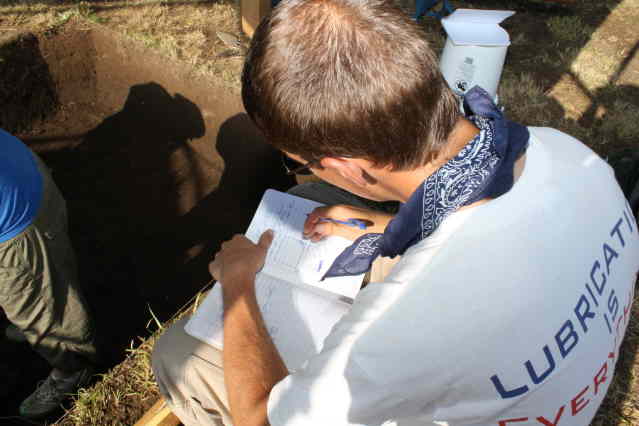
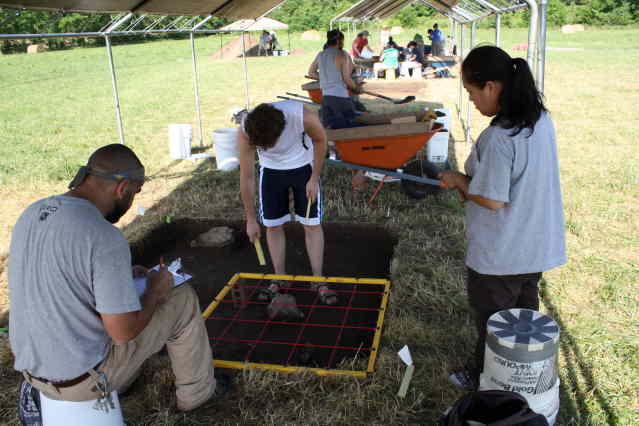
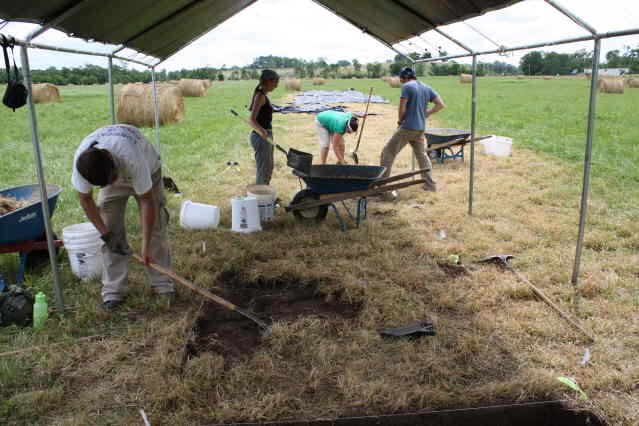
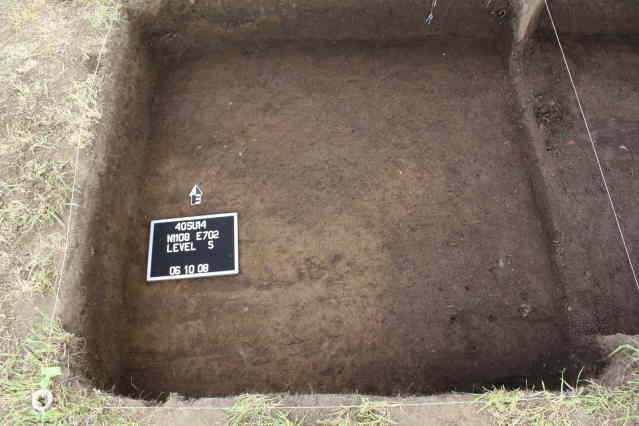
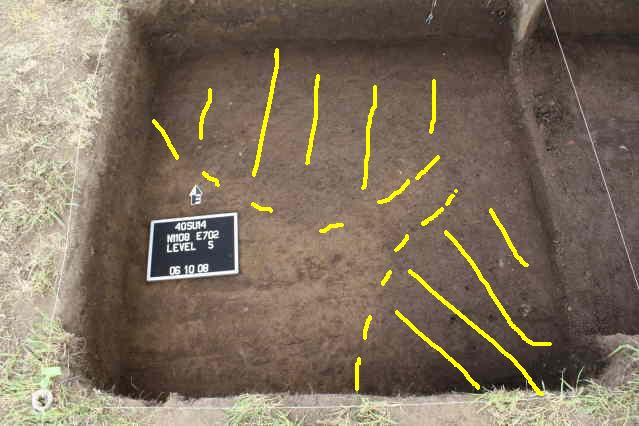
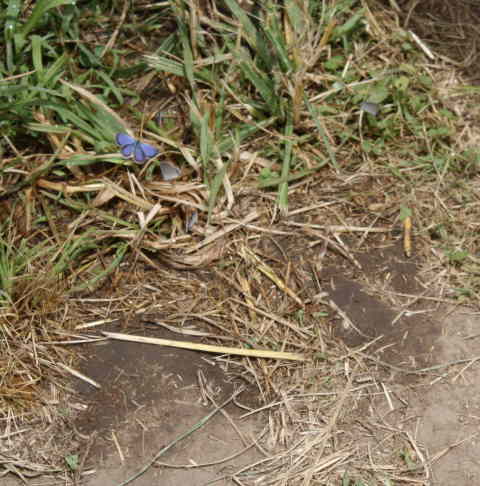


Today was a more typical June day -- hot, humid, and not much of a breeze most of the day. A nice day for archaeology in Middle Tennessee -- a cooler and overcast morning. Although the day started with about 75% humidity -- it had dropped to about 50% by midday and continued with some nice clouds and a breeze through the rest of the afternoon. The threat of showers and/or an isolated thundershower continues for the rest of the week -- but really a small chance. As we continued cleaning up several of our units today, we discovered a number of possible "features." Below, the photo shows four possible features. Feature 95 is a dark soil discoloration south of the large boulder; Feature 96 is a small pit or large post in the middle of the excavation area; Feature 97 is a possible small post -- and Feature 98 is a pair of long parallel soil differences running across the entire unit. Feature 98 was of special interest to us, since it appeared to represent a trench or ditch. The photo below highlights the outline of Feature 98 in yellow. Excavation of this feature will continue on Thursday. In each excavation unit we open in this area, we are recovering small triangular projectile points -- arrowheads used by Mississippian peoples for both hunting and warfare. The number we have found in this area is very large for Mississippian sites in the Nashville Basin -- hopefully, we will find additional clues as we continue excavation that will help to explain why this vicinity has so many lost or discarded projectile points. In a nearby unit, we discovered a round stain that appears to be a posthole (Feature 99). Investigating these features requires careful techniques -- below, the students have excavated half of this feature. The goal with "cross-sectioning" the feature is the get an understanding of the depth and shape of half of the feature. We can then use that information to excavate the rest of it in a more informed way. After class, we adjourned to our nearby field house for a late afternoon lecture.
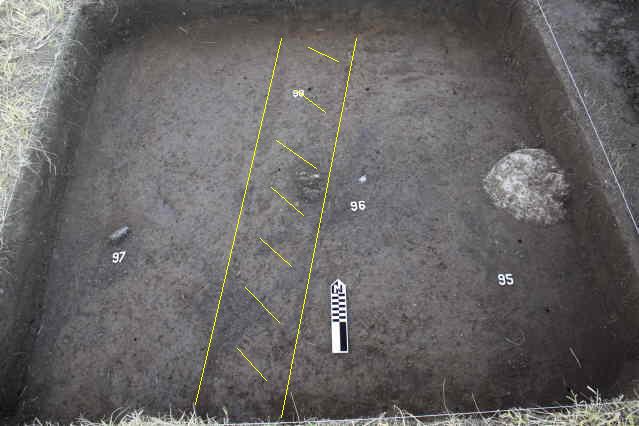
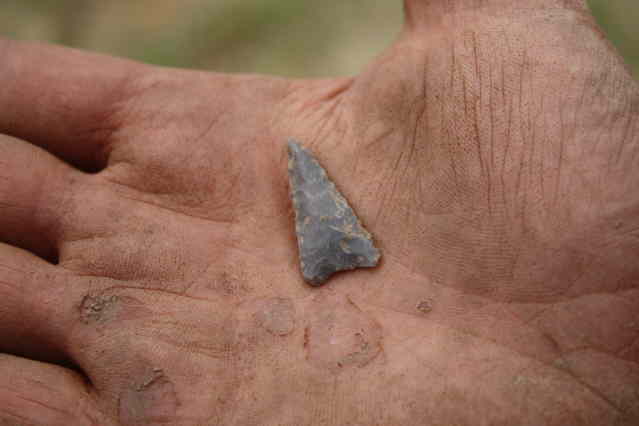
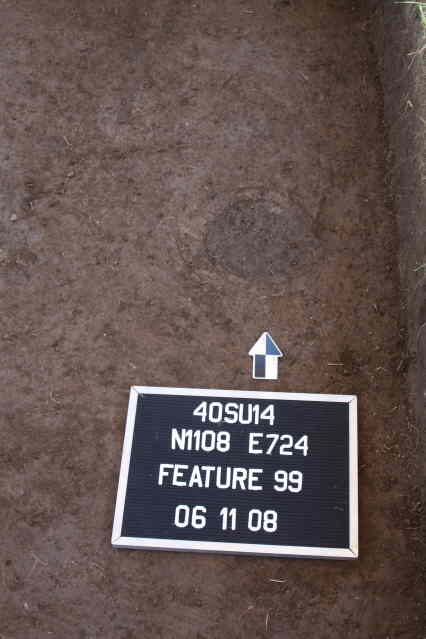

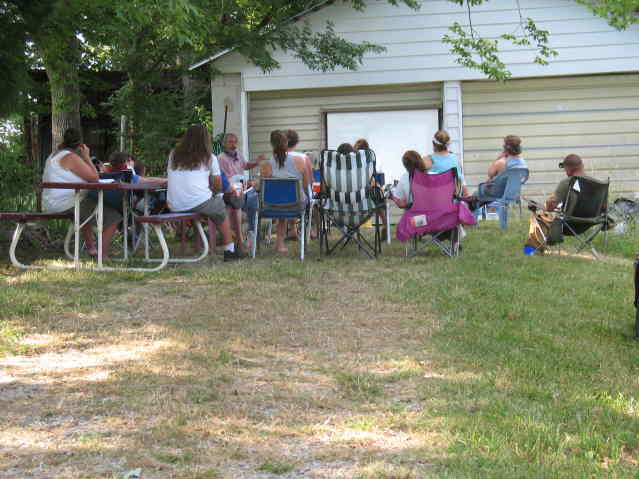
Another hot and humid day -- with a brief break in the afternoon when the clouds moved in. We continued working our way through the plowzone in most of our units today, so we don't have much "exciting" to report for today. One interesting historical feature that showed up today was a series of soil discolorations produced by a "subsoiler" or chisel plow. The first photo below shows these features -- the second shows them highlighted in yellow. Our mysterious "Feature 98" from yesterday also turned out to be a pair of these disturbances created by a plow. From our conversations with relatives, we feel fairly certain that Mr. Shoulders never used a subsoiler on the farm. So, we looked for possible other explanations for these features. Our best guess at this point is that when the drainage system for the field was installed in around 1920, these deep cuts were made in the field to divert water towards the trunk pipes. We also continued work on our posthole from yesterday -- in the photo below we have excavated a small area to show the complete profile of the post. The first photo below is a "side view" of the darker soil filling the post. The second highlights the outline in yellow. As several crews closed out their current units, we moved them to another location in the field to the south -- where we found a large garbage deposit back in summer 2007. On Friday, weather permitting, we will begin excavations of the wall-trench house discovered earlier in the week.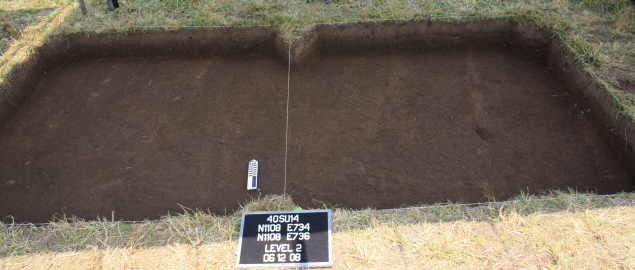
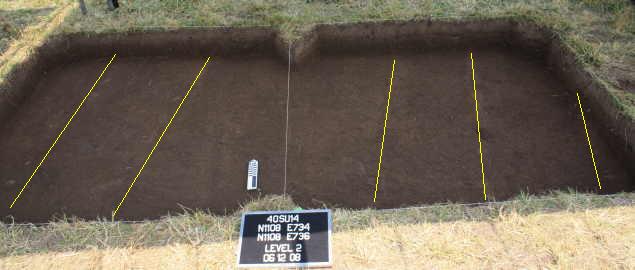

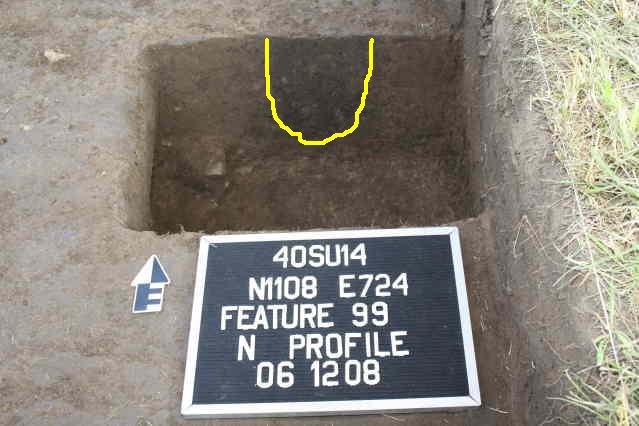
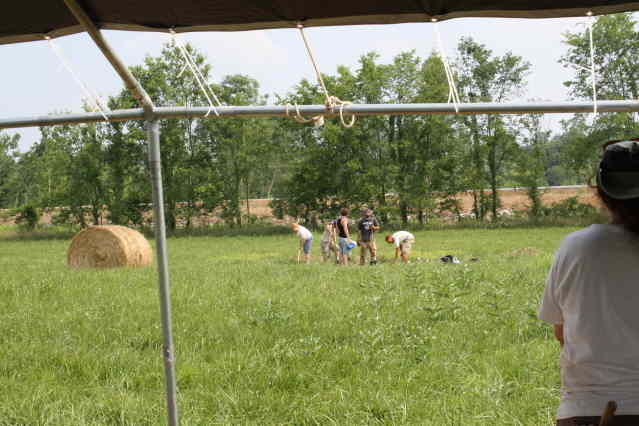
Although the day started off a bit cooler than usual and was overcast, there was virtually no breeze and the humidity was a bit sweltering in the early morning hours. As we finish out our second week of fieldwork, we are faced with some interesting discoveries -- and some perplexing lack of discoveries. We continue to find ample evidence of the presence of our Mississippian folks in every unit -- fragments of pottery are showing up in just about all of our excavation areas. We also continue to find projectile points (dart and arrow points) from as much as 4000 or 5000 years ago. While the artifacts are interesting, our main interests are in understanding the plan and layout of this prehistoric community around A.D. 1200. That means finding different areas of the site -- the main residential area, the public areas, and so on. Our work so far this summer has produced some interesting possibilities -- but also some intriguing challenges. Several of our excavation units have produced very little evidence of posts, pits, trenches, or other features associated with houses or activity areas. For example, the two units below show almost no evidence of past human activity (except for those recent plowscars from the 1920s or so). The absence of these features is important -- it tells us that these excavation areas are not in a place where houses were built. Our questions now are -- what was this part of this ancient town used for? Hopefully, our investigations in the next three weeks will provide some answers. Just a few meters to the west, we continued to work our way down to the possible house floor. The first photo below shows the dark soil within the possible house in four of our excavation units (about a 20 foot wide section). The second photo highlights what we think might be the outlines of the house in yellow -- and a possible hearth or fireplace in blue. More investigations on Saturday will perhaps clarify this picture a bit. After lunch, we continued work for about an hour -- but then some dark clouds began blowing in and I decided we should close up our field operations. When storms threaten, we move into our field laboratory to wash up artifacts from our excavations. As things turned out, the rain passed to the north and south of us -- but we did manage to get a significant number of artifacts washed up. Here, Matt, Ellen-Craig, Brady, and John wash up artifacts from last week's digs. We will continue our story tomorrow with our second volunteer day -- unless we are rained out!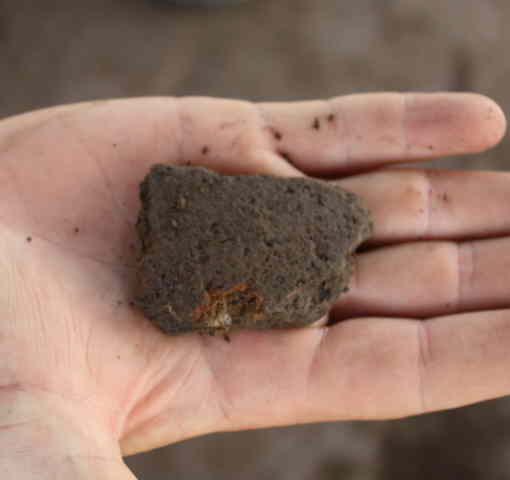

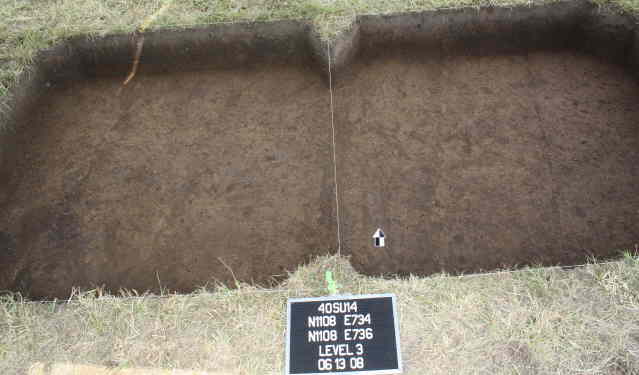
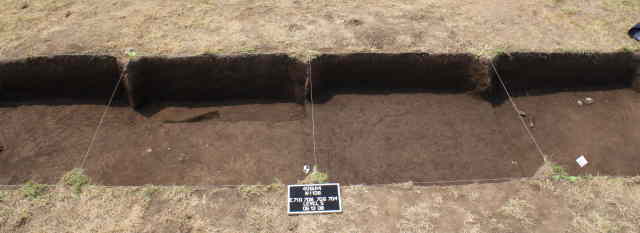

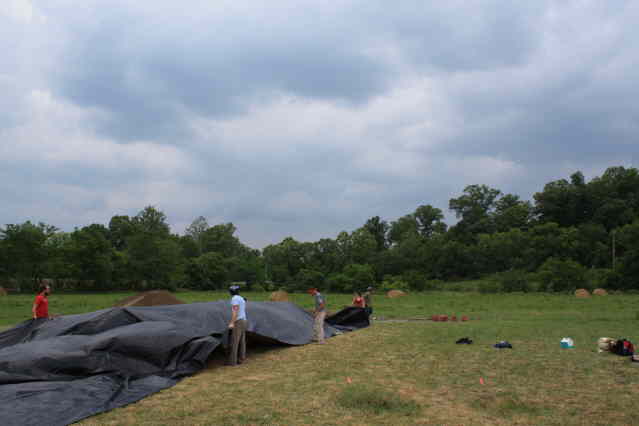
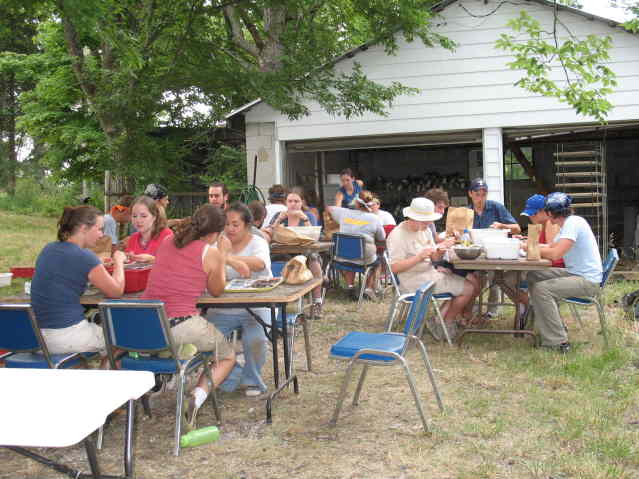
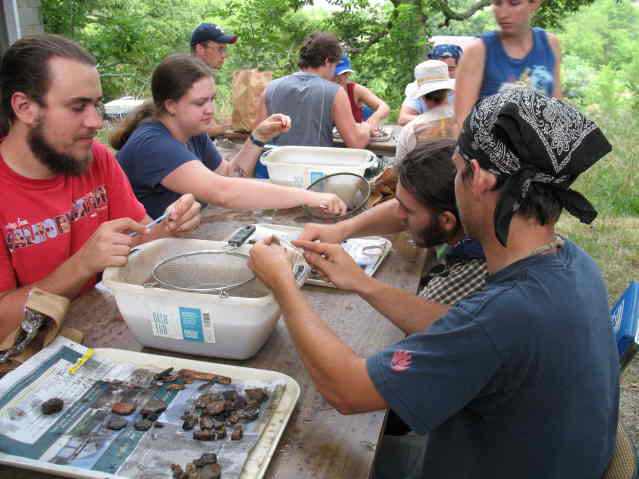
We started our second volunteer day with a cloudy sky and threat of showers, but decided to go ahead and charge ahead with excavation. As things turned out, we didn't get any rain -- and it was the most pleasant day for digging we've had so far. With fourteen of our crew and eight volunteers, we managed to accomplish a great deal during the day. Our thanks to our volunteers... Below, Heather and Tom Carden are screening artifacts from two of our new units... Emily's parents also joined us for the day... And, a couple of our favorite field school alums joined us for the day. Below Ryan McNutt (at left) examines a feature outside the frame while Chris Hogan and son Drew work at the screen with Nikki and Brittany. Bill Miller also joined us again today. Several of us continued work on the wall trench structure today -- finally identifying part of three walls. The first photo below shows the units. The second shows the three trenches highlighted in yellow. We'll open two or more additional units on Monday to further expose this structure -- hoping to catch at least two more of the corners of this structure by the end of our project in three weeks. Perhaps our most spectacular find of the day was a mandible (lower jaw) from a canid in a trash pit adjacent to the wall trench structure. This is probably from a Native American dog -- but we'll wait until our animal bone expert Dr. Peres returns on Monday to decide whether this might also be from a wolf or coyote. We are taking a break from our fieldwork on Sunday -- we'll be back with a new report on our discoveries on Monday evening.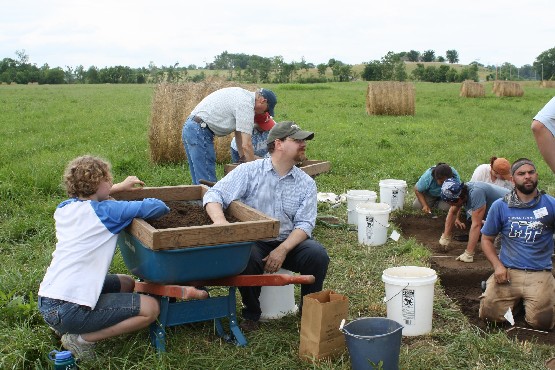
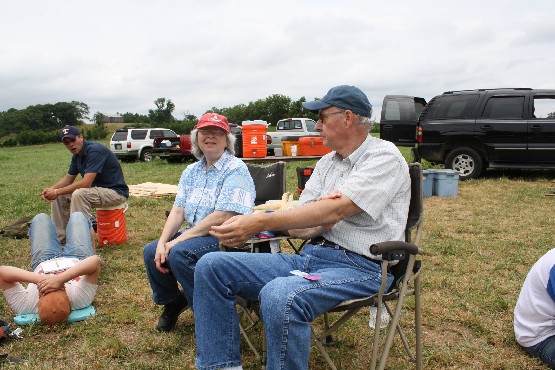
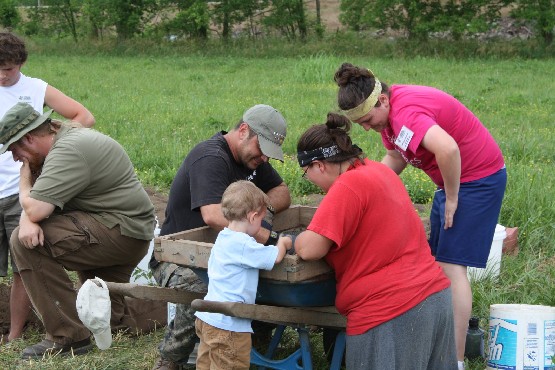
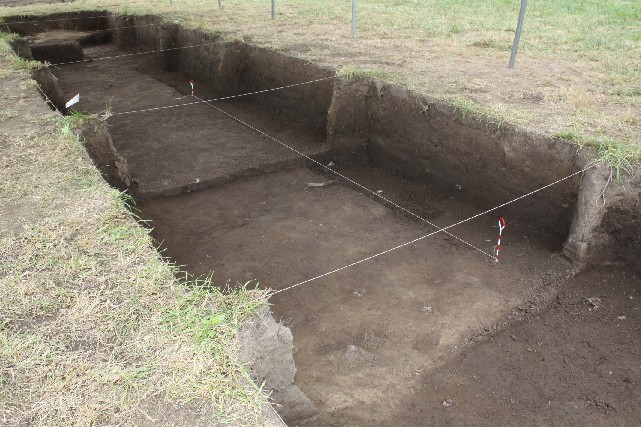
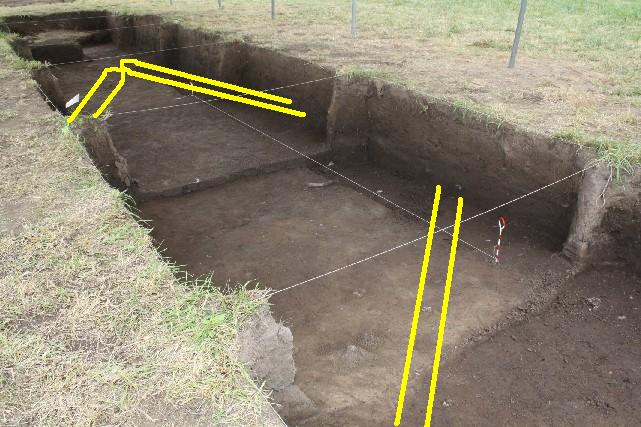
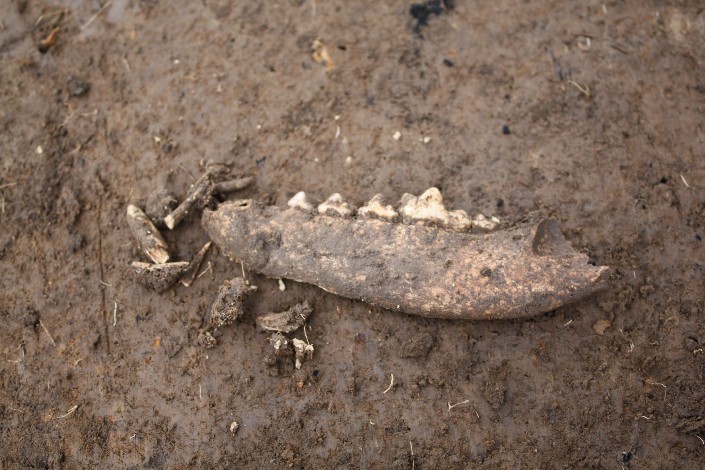
We started our third week of this summer project this morning -- a humid and hot morning and early afternoon. Then, the clouds moved in with a breeze for the last hour or so of the day. In the early morning when we arrived around 7:15 am, the local barn swallows had adopted our backdirt pile Today, we continued excavations on several new units -- before we can really investigate our wall-trench house, we need to finish a couple of additional units down to the floor level. In another area started on Saturday (the garbage deposit), we also missed the main feature with our first two units -- and need to expose a bit more of this area with two new units before starting a more detailed examination. Today, we also started our small exploration into Mound 2-- the large platform mound at the heart of this ancient community. This mound was not a burial mound -- it was built as a platform to support a building (probably the house for the chief and his/her family along with perhaps the community temple or shrine). Our goal with this small excavation is to see if we can find the garbage discarded at the back of the mound by the family that served as the leaders of this ancient Middle Tennessee town. Elsewhere on the site, we continued to investigate several possible human-created features. In one location, the feature turned out to be a natural geological feature -- a section of bedrock that had not weathered to clay. Among the artifacts recovered during the day was a very nice T-shaped drill -- this came from the plowzone above the wall-trench house.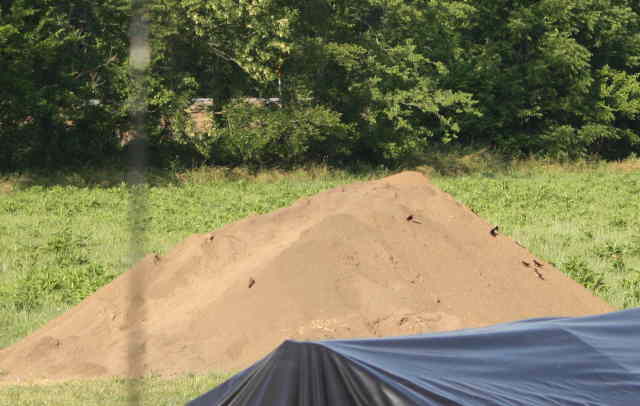

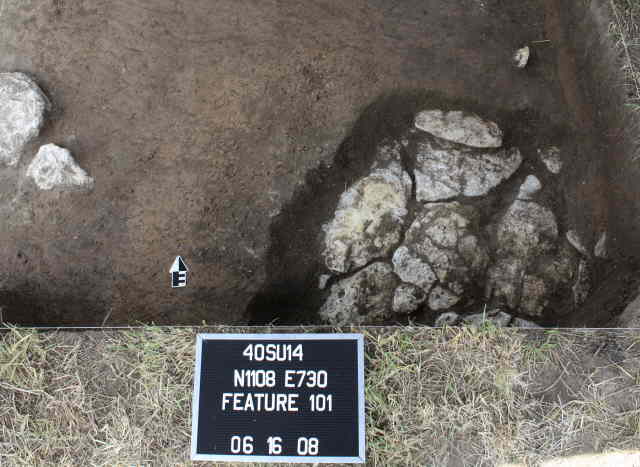
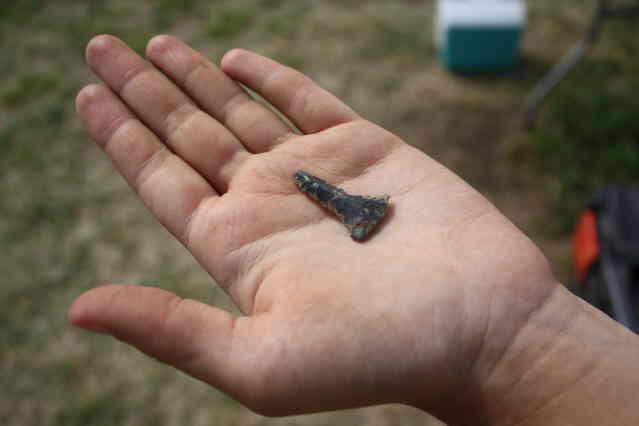
After the storm passed through last evening with the cold front, the morning temperatures were spectacular for archaeology -- low 60s. The high was around 80. Most of the crew finished excavating units through the plowzone to expose the tops of our major features -- the wall-trench house and the large garbage deposit. Below, Brittany, Clay, and Mallory shovel through the plowzone. For the morning, our friend Bill Carey (aka "History Bill") visited to film for a video destined for "Tennessee History for Kids".
Among the artifacts discovered today was a scale from a gar -- a freshwater fish. Although this specimen shows no signs of use (at least based on our field observations), Native peoples prized the scales of the gar for projectile points. Our limited exploration into Mound 2 continued today -- reaching below the plowzone and slopewash into what is starting to look promising for undisturbed mound levels. Some different colored soils are starting to show up (see below) -- at this point, these are hard to interpret. But, by the end of the day on Wednesday, we expect to have some better understanding of what these different colored soils represent.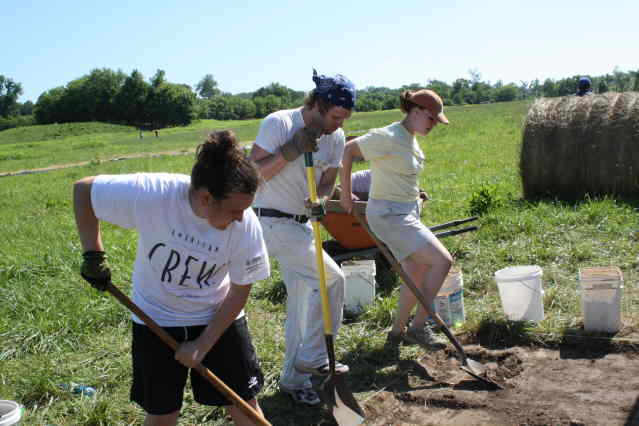

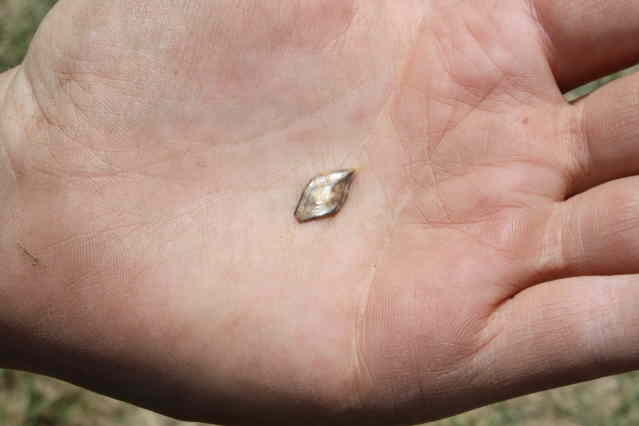
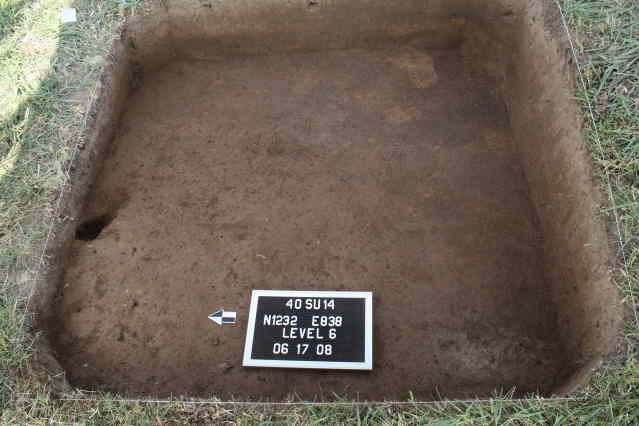
The weather continued to cooperate with another beautiful June day. Each day we entertain a number of visitors. Below Dr. Tanya Peres (Zooarchaeology Project Director) and I chat with Heather and Giovanna -- archaeology graduate students from the State University of New York at Binghamton -- along with Mike Moore (State Archaeologist) and Chuck, an archaeologist from Nashville. Most of our day was spent digging through another 10 cm to further expose some of our features in the south, east, and west units. We should have these cleaned up and ready for photography on Thursday. Each of these areas continues to produce quantities of interesting artifacts, like the large rim of a pottery vessel shown below. On Wednesday afternoons, we have a lecture (with pizza) to provide student with information on a variety of archaeology topics. Below, Dr. Peres gives the students some basics on identifying animal bones.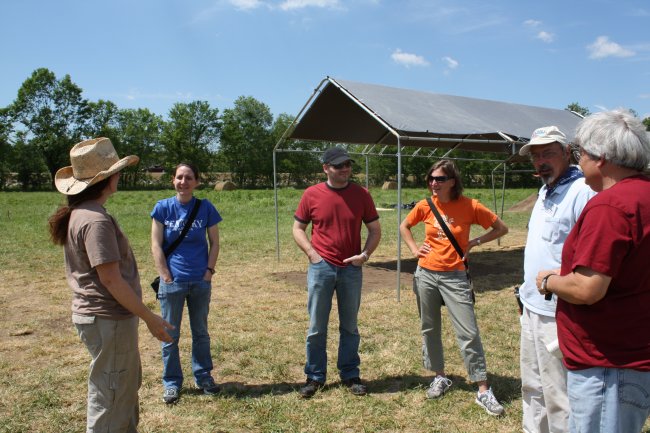


Once again, we really couldn't ask for better "digging weather" in late June. We continue to retrieve an amazing assemblage of broken pottery -- although perhaps not visually stunning, each of these pieces will be carefully analyzed in the lab and used to interpret the daily lives of the people who occupied this town. We are the first to see and touch these objects in about 900 years. As we finished recording the information in several of our excavation units, we backfilled them. Here, Matt, Brittany, Jaime, and Jolene load the wheelbarrows in preparation. Unfortunately for us and the local farmers, we are in a bit of a dry spell in Castalian Springs. Although it has rained quite a bit elsewhere in Sumner County, we haven't had much rain here at the site. As a result, we have to spray down some of our drier units in order to see the different soil colors. Below, I'm using a water sprayer to carefully "re-hydrate" four of our excavation units. After a spritz of water, the different soil colors are much more visible -- the lighter clay does not retain moisture well while the more organically enriched soil absorbs the water and the darker brown stands out. At this point, a couple of probable circular pits are visible -- along with an irregular feature that may be an erosion gully, ditch, or trench filled with trash. To the west, our possible wall trench house turned out to be something entirely different -- a series of overlapping pits or basins. Before investigating them further, we excavated a large historic period posthole (Feature 105) that had intruded into one of these pits -- the large round posthole contained fragments of a late 1950s or early 1960s Nehi bottle. It probably is part of a fenceline. Over at Mound A, our excavations revealed a row of postholes about a meter deep. Below, the postholes are highlighted in yellow. These appear to represent part of a structure that stood on an earlier version of the Mound. We will excavate these on Friday. Currently, our mound unit shows three probable building stages of the mound. These are highlighted below in blue and yellow. Interestingly enough, all three of these stages are "flat" -- no signs of the construction of the large conical mound are yet visible. This tells us that the earliest construction of the mound was a large flat-topped platform -- and that the conical mound was a later addition. If our preliminary interpretations are correct, each stage of the mound was capped with a layer of light yellow-brown clay. The five postholes originate at the yellow line shown below.

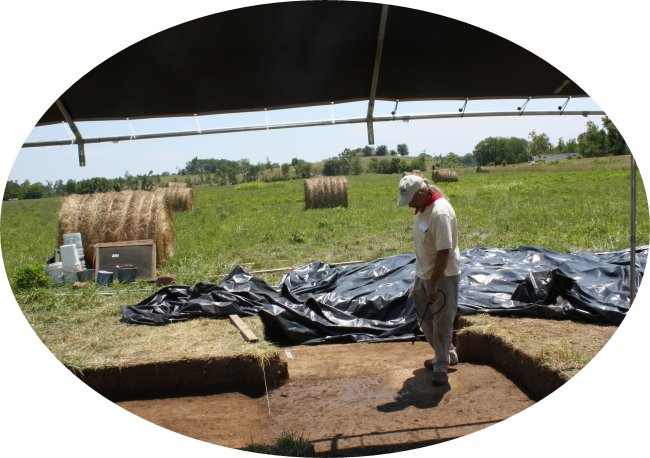

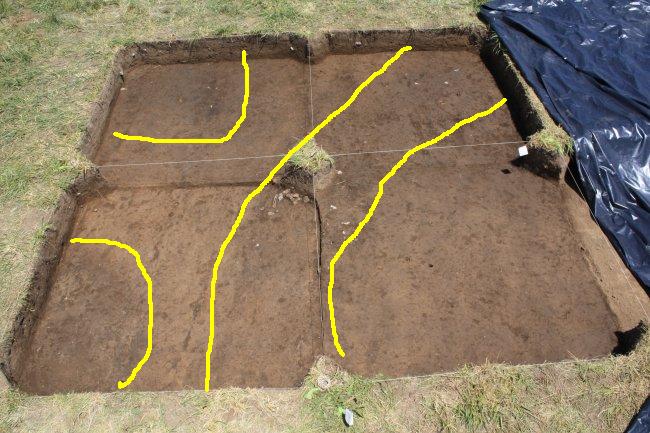

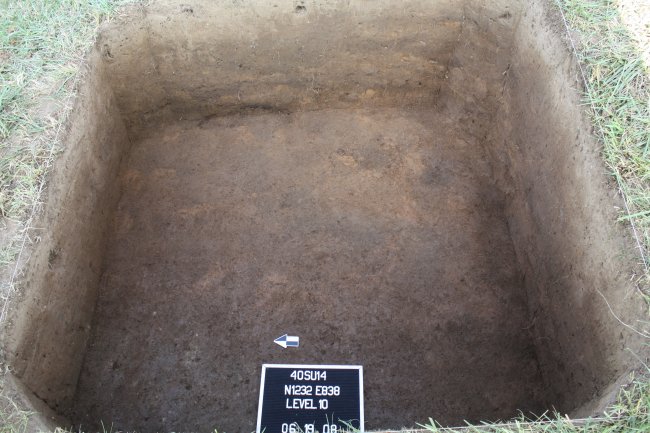
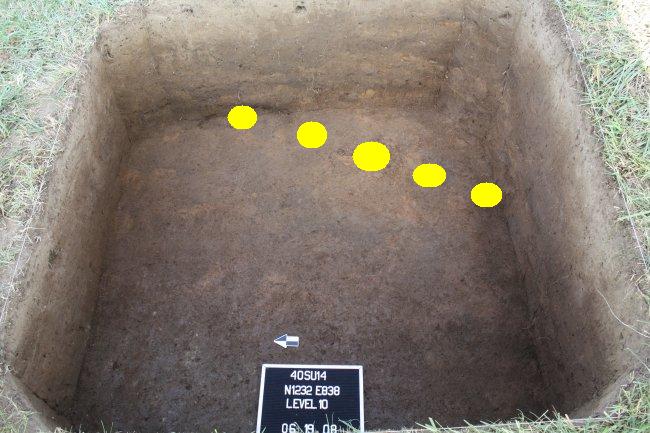
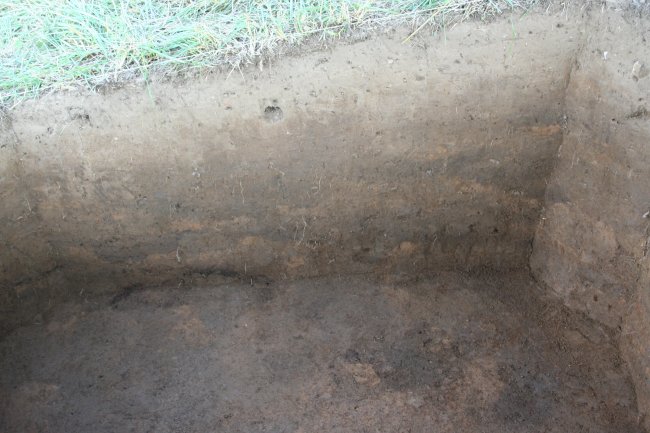

Today was a bit more on the warm side -- but still quite pleasant for late June in Middle Tennessee. Excavation of one of our large basin shaped pits on the west end yielded a complete mandible (jaw) of a prehistoric dog. Elsewhere, we are working on a very exciting trash deposit -- this dense scatter of garbage accumulated over a period of time as local families discarded debris from their houses. Below, everything in the unit is an artifact -- everything but the kitchen sink. We have recovered several bags of pottery -- including large cooking pots, storage vessels, small bowls, and large pans. The whitish objects in the photograph are deteriorating pieces of limestone -- probably originally used to line fireplaces and hearths in nearby structures. The bone preservation in this midden is extraordinary -- we have recovered hundreds of pieces discarded from meals. These fragments include deer, turkey, bear, turtles, fish, snakes, and many others that will be carefully examined in the lab to tell us more about the diet of the Castalian Springs people. Below, Nemanja and Kristen carefully expose and remove fragments of pottery and animal bones from the midden. Below is a finely worked drill from the midden deposit. Over at Mound 2, excavation of the circular stains did indeed prove them to be postholes (about 45 cm in depth) -- there is a fifth post at left, but not enough of it was exposed to allow excavation. Interestingly enough, three of these posts are slanted outward while the fourth is an upright post. This suggests the possibility that the edge of the mound was surrounded by an outward slanted defensive wall at least during part of its existence. At least two more of the yellow-brown clay "caps" are visible in the walls of the postholes -- where these posts were dug through earlier building stages.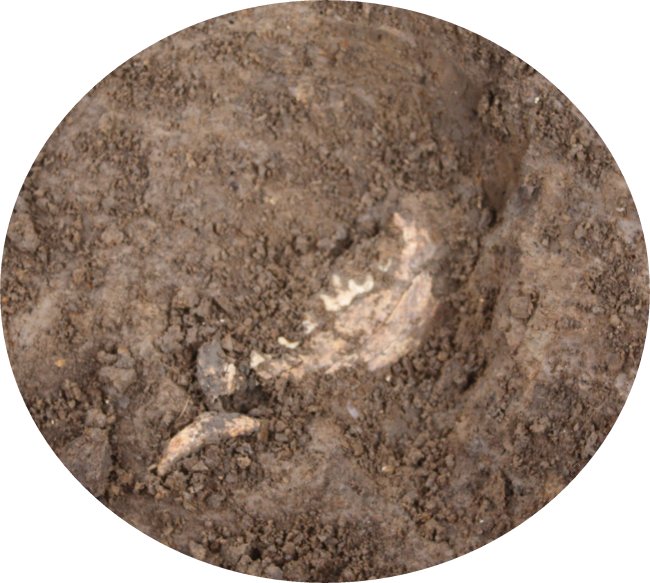


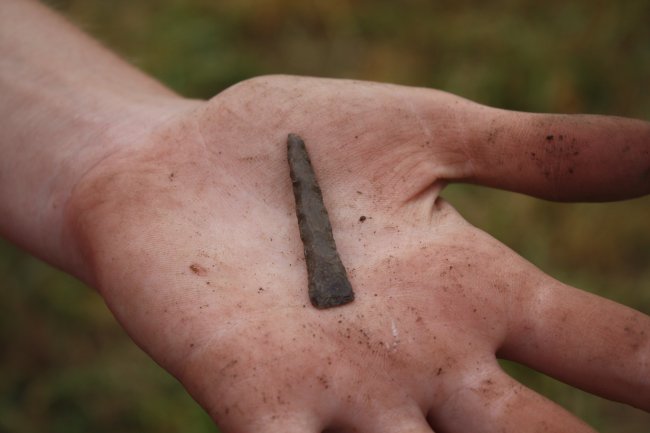

Our third volunteer Saturday started with a nice shower at about 7:30 am. The rain quickly passed over and we were at work with several volunteers by our usual Saturday start time of 9:00. On the west end, our overlapping series of pits continue to grow larger and deeper as we excavate them -- at this point, we're not certain what these represent -- only further investigation will provide the clues. They do not have a large amount of artifacts in them, but the fill is darker and every now and then a large shard or pottery or animal bone is recovered. Below, Matt and Emily work to find the bottom of one of these basins. The tremendous amount of fill in these basins kept our students and volunteers busy screening through the morning and early afternoon. Below, crew members Matt and Nikki screen at left while volunteer James works with crew member and spouse Salina and volunteer Bill Miller. The large dense midden deposit continues to extend deeper -- yielding bag after bag of ancient refuse. Below, Dr. Peres works with volunteer and alum Brandy Dacus in this excavation. The quantity of artifacts in the midden dirt kept many of our volunteers busy (and happy!) retrieving fragments of pottery, small animal bones, and stone tool fragments. Below, Dr. Peres excavates while Tom and Heather screen. At right, Georgia Dennis checks the wheelbarrow. Our regular volunteers Edie and Caroline also assisted during the day with this excavation. In order to find where this midden begins, we opened another nearby excavation. Below, you can see one of our backfilled units at right -- this unit did not contain the midden. Brady and John quickly but carefully excavated their way through the plowzone in the new unit to expose the top of the midden. Because we already have a sample of the plowzone from the adjacent units, we are not screening the plowzone in this unit. However, volunteers Georgia and Judy are retrieving a "grab bag" sample from the wheelbarrows. Back on Mound 2, Crew members Nemanja and Natasha work with crew chief Erik and his dad Steve. We are deep as we can safely excavate in our first unit, so a new unit is being opened adjacent. This "step trench" method will give us a partial glimpse of the construction of the mound. Although it was tempting to try to follow the line of posts further, we decided to stick with our original plan for now. Our main goal with this limited mound excavation is to examine the construction sequence -- the unit we are opening should go deep enough to reveal some additional details of the lower strata. If we can reach the slope of the mound, we also hope to encounter some trash deposits thrown over the back side of this mound while it was in use. Perhaps early next week will reveal some more details. If time permits (only two weeks left!), we'll consider pursuing our line of posts further. Around 2:00 pm, several thundershowers headed our way -- so we closed up early. The rain, although brief, was welcomed by all! Now, the staff and crew look forward to enjoying our one day off from the project. We'll be back on Monday to continue our explorations at Castalian Springs.

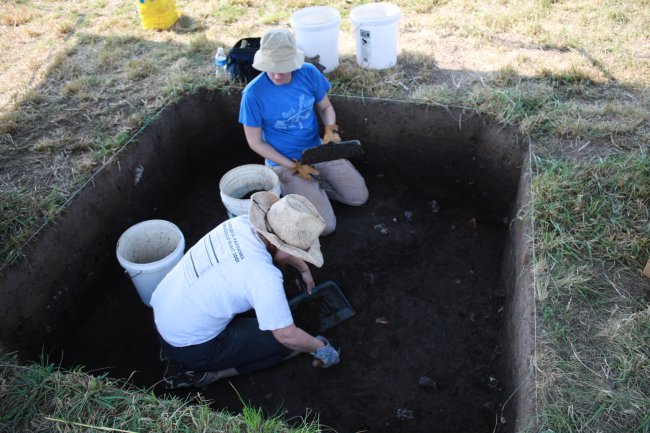
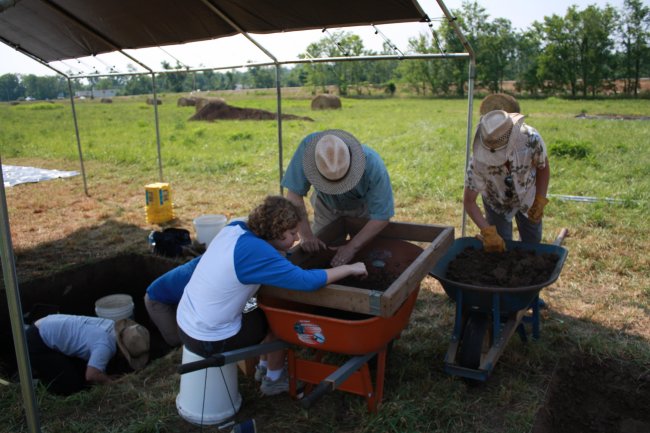
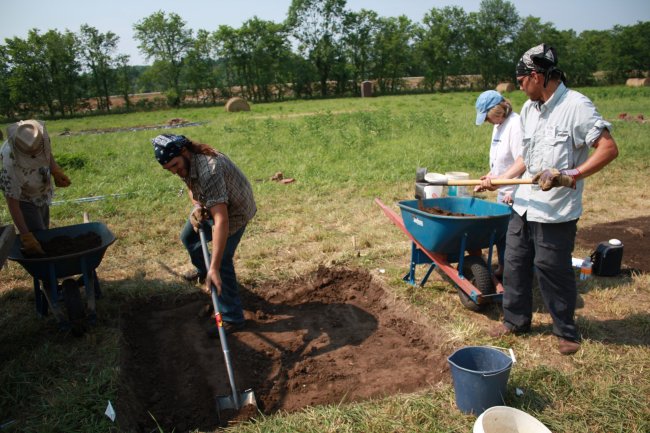
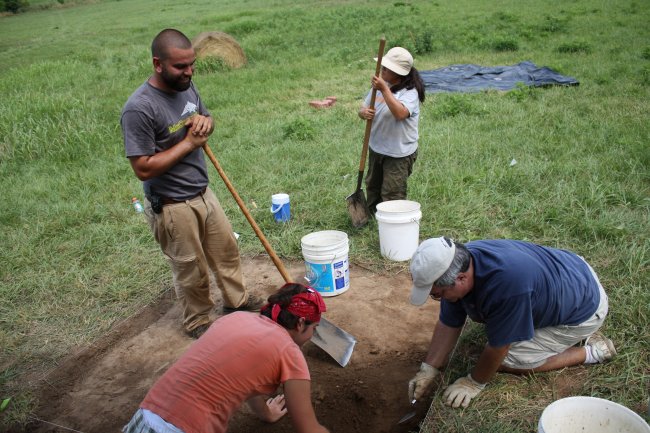
Another nice day in Castalian Springs -- cloudy in the early morning and then clearing up for a sunny but not too warm afternoon. Our crews continued work in the midden deposits on the east end -- discovering many additional fragments of pottery, animal bones, and stone tools. The large pottery sherd below is from a large wide rimmed plate (similar to what we might call a "soup plate") -- you can see the "well" on the lower right of the sherd. Another large sherd shown below is from a large pan -- the bottom is impressed with the fabrics used to line the mold when the pan was created. Over on the east end, other student crew members continued exploring the large pits -- one of which is starting to look more like a ditch or trench. Among the more interesting finds from today was a large portion of a broken cooking pot with handle. The new unit we opened on Saturday to explore the midden further did prove to contain the same type of dense garbage deposit -- the photo below shows the top of this artifact deposit just below the plowzone. In the late morning, my nephew Keaton showed up to assist with the excavations. Below, Keaton shows off one of his discoveries to Brady and Kendra. Over at the mound, we continued our explorations today -- some more photos and news tomorrow. One of our visitors today was a male purseweb spider -- rather ominous looking, but just a curious neighbor.
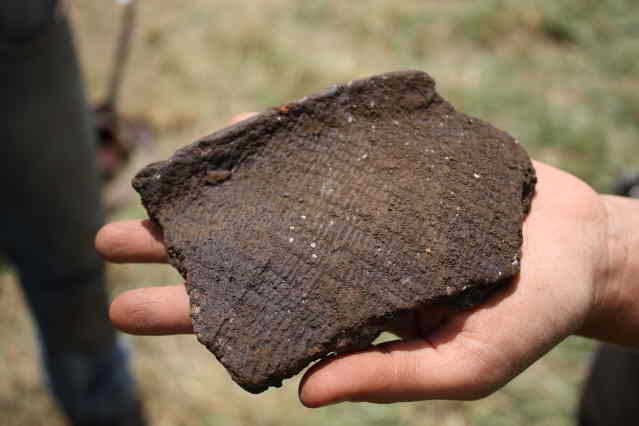
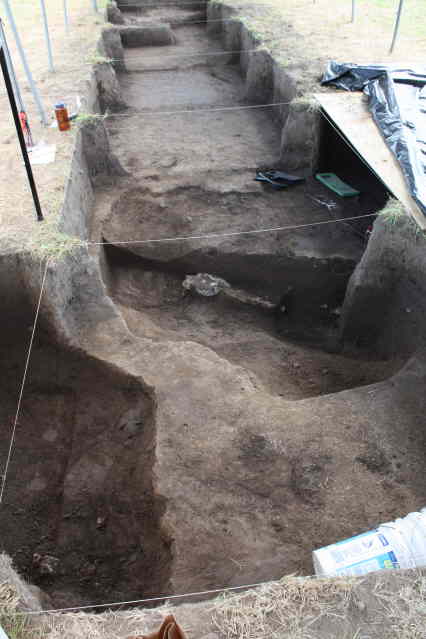
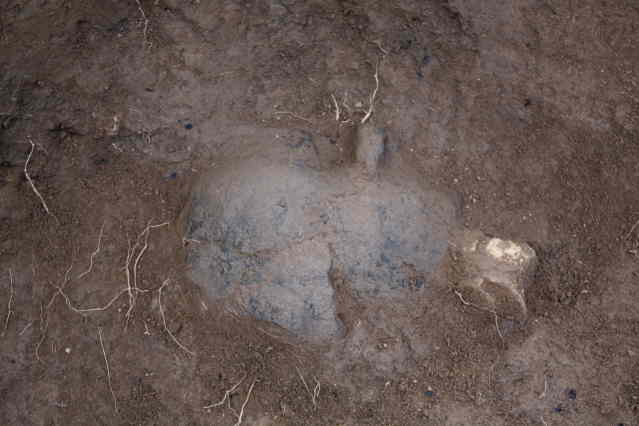
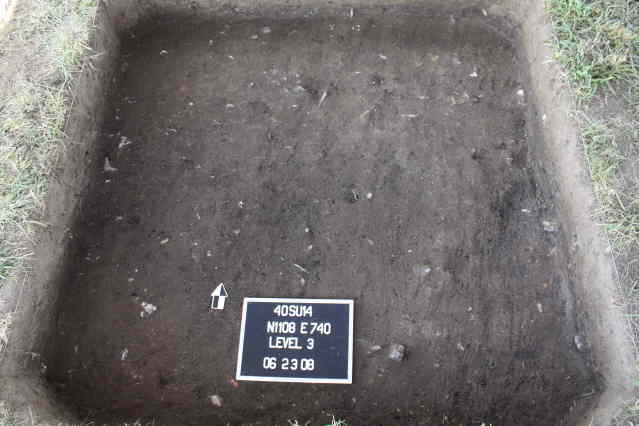

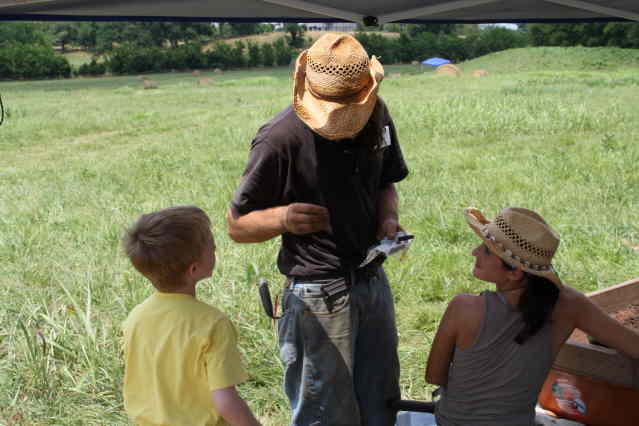

As our time in the field starts to wind down, we have many tasks to finish. In several of the units where we have finished excavations and recorded all of the information we need, we have "backfilled" them with sifted dirt and replaced the sod. The excitement continues as we continue to uncover new clues to the town that occupied this site around A.D. 1200. Below Ellen-Craig, Matt and Nikki continue to try to figure out the outline of one of the pits in our west side excavations. We continue to find exciting pieces and parts of the pottery used, broken, and discarded here almost a millenium ago. Below, a handle from a small pot offers some clues to the age of the site -- this style of handle is most common around A.D. 1200. And from the midden,another large part of a wide-rimmed plate. The midden also continues to yield exceptionally well preserved animal bones -- including the two bone tools shown below. These are both probably awls or punches. Because one of our goals of the project is to discover the smallest items, we are also excavating some column samples -- all the soil from these smaller excavation units is saved in bags and will be sorted and examined in the laboratory. This will allow us to recover the tiniest fragments of animal bone, seeds, and other small objects that would drop through our 1/4 inch screens undiscovered. Below, Dr. Peres and Lacey work on excavating one of our column samples.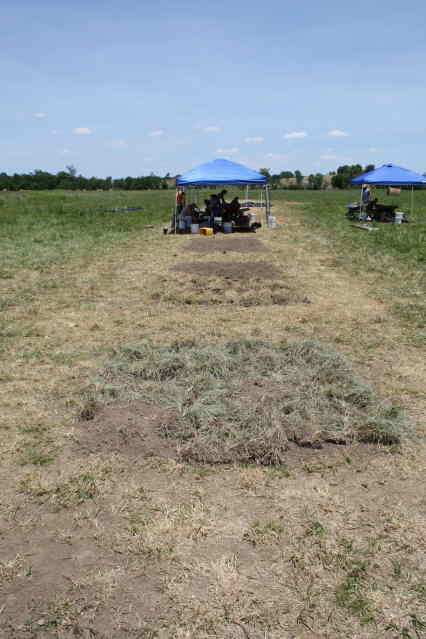
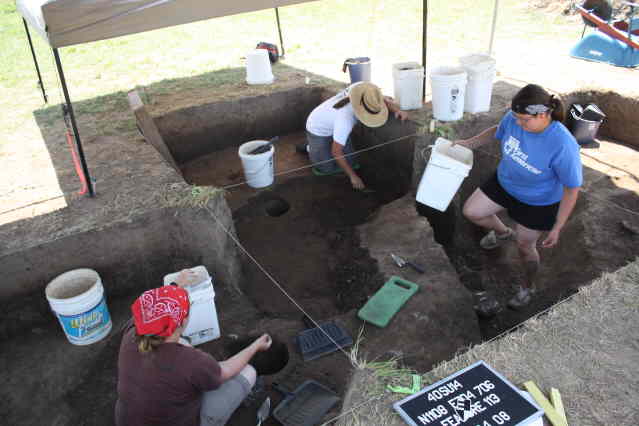

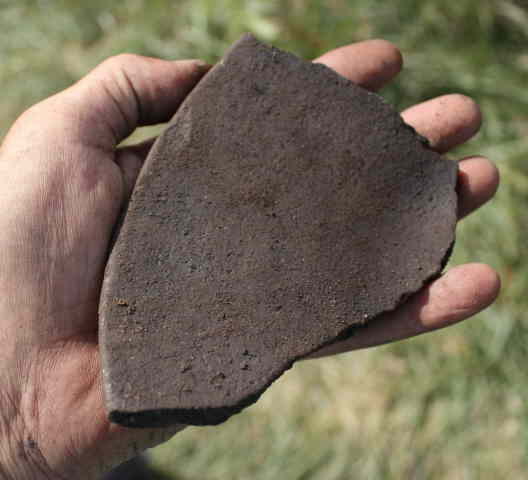
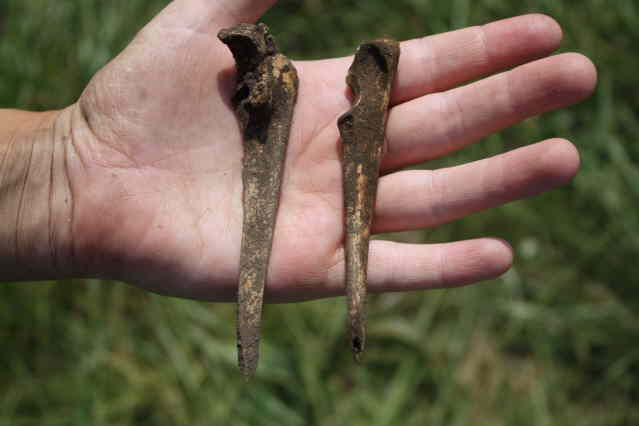
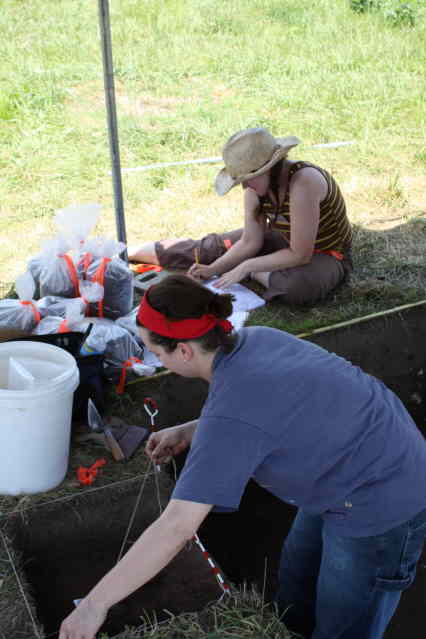
A busy day continuing our excavations -- and the hottest and most humid to date. We had an interesting caterpillar visitor today. The midden continues to produce many examples of pottery and animal bone. Below is a fine specimen of deer leg bone -- exceptionally well preserved. Our pits to the west also continue to produce interesting fragments of pottery -- including the jar fragment with handle shown below. We also took a break today to take our annual "Crew Photo" -- below is the tremendous crew and staff that have worked hard to discover new things about the history of Tennessee between A.D. 1150 and 1300.
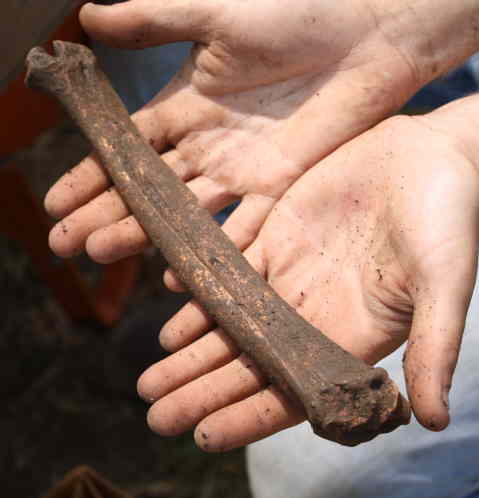
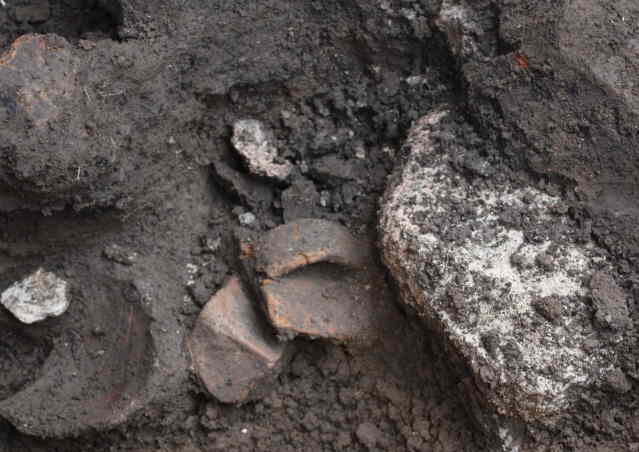
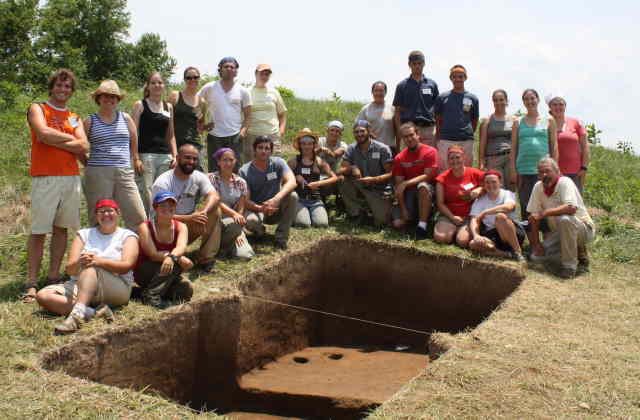
Our days continue to be busy as we look towards closing our project down next week. Today, we had a distinguished visitor from the University of Alabama -- Dr. Jim Knight. Jim has visited our project every summer and we appreciate his wisdom and advice. Below, Kim continues to clean up the bottom of one of our large pits on the west end. Later in the day, the carefully cleaned up pit shows the collection of artifacts at the bottom -- including an interesting section of deer antler at the left. The tines had been removed for use as tools and the rest discarded. Intriguingly, a section of antler tine that had been scored and snapped was found later in the day in this same pit. We also discovered a fascinating piece of stone tool from the midden on the east end -- this expedient cutting tool is made from Dover chert. This particular type of highly valued flint is found on the western edge of the Nashville Basin -- near Dover, Tennessee. Our mound excavations continue to produce some exciting results -- our second unit in the mound shows some clear mound construction fill at the upper left of the photo below. To the right and lower portion, we appear to have exposed the edge of a mound construction stage. Finally, as we close out one of our few remaining days -- we are constantly working on notes and records. Below Tyler and Jaime record the profiles of their unit with instruction from Teresa.
